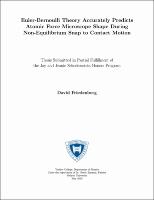Please use this identifier to cite or link to this item:
https://hdl.handle.net/20.500.12202/5610Full metadata record
| DC Field | Value | Language |
|---|---|---|
| dc.contributor.advisor | Zypman, Fredy | |
| dc.contributor.author | Friedenberg, David | |
| dc.contributor.author | Yeshiva University, degree granting institution. | |
| dc.date.accessioned | 2020-06-08T20:13:20Z | |
| dc.date.available | 2020-06-08T20:13:20Z | |
| dc.date.issued | 2020-05 | |
| dc.identifier.citation | Friedenberg, David. (May 2020). Euler-Bernoulli Theory Accurately Predicts Atomic Force Microscope Shape During Non-Equilibrium Snap to Contact Motion Thesis Submitted in Partial Fulfillment of the Jay and Jeanie Schottenstein Honors Program. NY: Yeshiva College. Yeshiva University. May 2020. | en_US |
| dc.identifier.uri | https://hdl.handle.net/20.500.12202/5610 | |
| dc.description | Honors thesis. Open Access. | en_US |
| dc.description.abstract | We find that the Euler-Bernoulli theory is an appropriate framework to predict the kinematics of the cantilever during the far-from-equilibrium snap-to-contact event. We show by direct comparison with Doppler Vibrometry experiments the validity of the force-separation reconstruction algorithm based on the Euler- Bernoulli equation. Specifically, we did this comparison for the case of a cantilever undergoing far-fromequilibrium motion driven by nonlinear forces during the snap-to-contact event. The relevance of our result is that, unlike in the experiment used here, conventional atomic force microscopy experimental conditions allow collection of the slope or position versus time at only a single point on the cantilever. However, as seen in the Methods section, a distinct algorithm can be formulated to deal with this data as well. While our rendering of the Euler-Bernoulli-based algorithm allows for the reconstruction of the full shape of the cantilever at all times, the reliability of these shapes rests ultimately on the validity of the model used. Our proof thus paves the way to use our reconstruction algorithm under conventional atomic force microscopy operating conditions. The time-consuming multiple Doppler Vibrometry measurement, while central to our test, is shown here to be no longer needed when running conventional atomic force microscopy experiments. Indeed, once one knows that Euler-Bernoulli can be used during snap-to-contact to predict the shape of the cantilever, the bending forces are readily attainable. In other words, our results should extend the ability to produce accurate force-separation curves from conventional voltage-time traces into far-from-equilibrium motion and nonlinear interactions. (from Conclusion) | en_US |
| dc.description.sponsorship | Acknowledgments I would like to acknowledge the National Science Foundation (NSF Grant No. CHE-1508085), as well as The Alexander Fund, and The Kresse! Fellowship at Yeshiva University for funding this research. I would also like to acknowledge Dr. Oliver Payton and Dr. Loren Picco at the University of Bristol for supplying the much needed Laser Doppler Vibrometry data to help us verify our theory. I would like to thank Dr. Steven Eppell for the time he spent working with Dr. Zypman and me in analyzing the experimental data and helping with the error analysis to obtain our final results, and for his help ensuring that our final published paper made it into official publication. Finally, I would like to thank Dr. Fredy Zypman for his time and effort working with me over the three years that we have done this research together. He helped me to become a competent physicist and taught me the importance of efficiency, collaboration, and hard work in completing fulfilling scientific research. | en_US |
| dc.language.iso | en_US | en_US |
| dc.publisher | New York, NY: Yeshiva College. Yeshiva University. | en_US |
| dc.rights | Attribution-NonCommercial-NoDerivs 3.0 United States | * |
| dc.rights.uri | http://creativecommons.org/licenses/by-nc-nd/3.0/us/ | * |
| dc.subject | Senior honors thesis | en_US |
| dc.subject | Euler-Bernoulli Theory | en_US |
| dc.subject | Atomic Force Microscope Shape | en_US |
| dc.title | Euler-Bernoulli Theory Accurately Predicts Atomic Force Microscope Shape During Non-Equilibrium Snap to Contact Motion. | en_US |
| dc.type | Thesis | en_US |
| Appears in Collections: | Jay and Jeanie Schottenstein Honors Student Theses | |
Files in This Item:
| File | Description | Size | Format | |
|---|---|---|---|---|
| Friedenberg Thesis.pdf | 1.12 MB | Adobe PDF |  View/Open |
This item is licensed under a Creative Commons License

